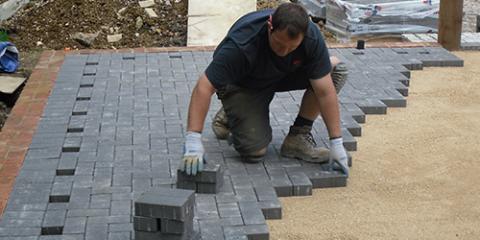Will De-Icers Harm Your Property? Kenton County Brick & Stone Contractors Explain

When winter hits Kenton County, it usually means clearing snow and ice from your sidewalk and steps. Snow can easily be removed by shoveling, but ice may require salt or de-icing products. But is this safe for your sidewalks and building?
The brick and stone contractors at Darryl Myers Brick in Independence warn that using salts or de-icers may damage your masonry surfaces, cause mortar joints to prematurely deteriorate, and harm nearby vegetation.
If you decide to use a de-icer on your walkways, Darryl Myers Brick suggests a few tips to keep in mind:
 Clear With A Shovel: Use a shovel to clear as
much of the snow and ice as possible. If your concrete is less than six months old, it
can sustain severe damage from the chemicals in your de-icing product, so you may want to stop after this step and avoid de-icers all together.
Clear With A Shovel: Use a shovel to clear as
much of the snow and ice as possible. If your concrete is less than six months old, it
can sustain severe damage from the chemicals in your de-icing product, so you may want to stop after this step and avoid de-icers all together. - Keep De-Icers Away From Plants: Avoid using salts and de-icers near vegetation, because this can upset the delicate pH balance of your soil and plants. Try to keep salt near the center of your walkways to avoid direct contact with your lawn.
- Avoid The Base Of Your Building: If de-icers come into contact with the base of your building, the masonry can flake off. If you want to avoid repairs, keep salt at a safe distance from your home or business' foundation.
- Dilute Your Salt: To create more traction and mitigate the damage to your walkways, the brick and stone contractors suggest combining sand with the salt.
- Rinse Away De-Icers & Salt: Don’t forget to rinse the salt and de-icers off of your walkways once the ice has thawed.
The brick and stone contractors also urge you to always read the manufacturer’s directions before you begin spreading the de-icer. You should never use products that contain ammonium nitrate or ammonium sulfate, because these chemicals can damage even the strongest masonry.
They also offer some tips on the four most common types of de-icers and which ones should be avoided:
 Sodium Chloride: This
product—also known as rock salt—is the most common de-icing product. A high
amount of chloride is released when it dissolves, which can damage metal
and concrete. Darryl Myers Brick suggests avoiding sodium chloride in favor of less destructive options.
Sodium Chloride: This
product—also known as rock salt—is the most common de-icing product. A high
amount of chloride is released when it dissolves, which can damage metal
and concrete. Darryl Myers Brick suggests avoiding sodium chloride in favor of less destructive options.- Calcium Chloride: This material comes in round, white pellets and can cause irritation if your skin is moist when you handle it. The professionals at Darryl Myers Brick advise avoiding this de-icer as well, because these chemicals will also damage concrete.
- Potassium Chloride: Potassium chloride is the safest option for your skin and plants. It will melt snow and ice unless the temperature drops below 15 degrees Fahrenheit. In colder conditions, you may need to combine potassium chloride with other de-icers or keep up a steady shoveling regimen.
- Magnesium Chloride: This de-icer will melt snow and ice when temperatures are as low as -13 degrees Fahrenheit and releases 40% less chloride when it dissolves, so it does less damage to concrete and vegetation. If you need heavy-duty melting power, this is a good choice.

No matter how careful you are, when you use de-icers, there’s always the possibility of damage to your concrete and other masonry. Call Darryl Myers Brick at (859) 743-3850 when you need repairs to your stone, brick, or concrete surfaces. You can also visit the brick and stone contractors online for more information about their provided services in Kenton County, including brick sealing and fireplace repairs.
About the Business
Have a question? Ask the experts!
Send your question

